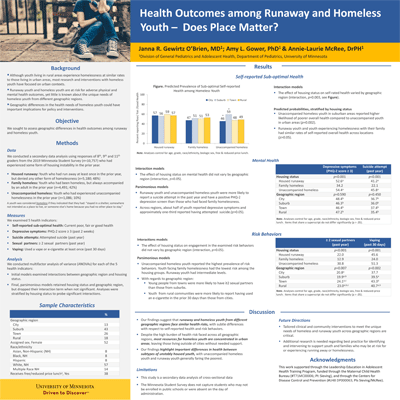Janna Gewirtz O’Brien
MPH, Public Health Administration & Policy
Co-Authors:
Annie-Laurie McRee, Amy L. Gower
Advisor:
Dr. Annie-Laurie McRee
Educational Objectives:
Assess geographic differences in health among among subgroups of unstably housed youth in cities, suburbs, towns, and rural areas across Minnesota.
Keywords:
Homeless youth, Geographic location
Abstract
Purpose: Youth face similar rates of homelessness across geographic regions, yet most research has focused on urban settings and little is known about the health of homeless youth from rural areas, towns and suburbs. We sought to assess geographic differences in health among runaway and homeless youth.
Methods: We conducted a secondary data analysis of 2019 Minnesota Student Survey responses from 8th, 9th and 11th graders who had been unstably-housed in the prior year (n=10,757), including running away (48%) or experiencing homelessness with (42%) or without (10%) an adult family member. We conducted multifactor analysis of variance to assess differences by geographic region (urban/suburban/town/rural) for each of five health indicators: self-reported health, depressive symptoms, suicide attempts, number of sexual partners, and e-cigarette use.
Results: The effect of housing status on self-rated health varied by geographic region (interaction, p=0.003). Suburban unaccompanied homeless youth reported poorer overall health compared to those in cities (p=0.002). Runaway youth and youth experiencing family homelessness reported similar overall health across locations (p>0.05). The effect of housing status on mental health and risk behaviors did not vary by geographic region (interaction, p>0.05), though there were small geographic differences in risk behaviors (≥2 sexual partners, p=0.007; vaping, p=0.002).
Conclusions: Our findings suggest that unstably-housed youth face a similar burden of poor health across geographic regions, with subtle differences in self-reported health and risk behaviors. Future research is needed to identify how to best meet the health needs of unstably- housed youth in suburbs, towns and rural areas.
Support
This work was supported through the Leadership Education in Adolescent Health Training Program, funded through the Maternal Child Health Bureau (#T71MC00006; PI: Sieving), and through the Centers for Disease Control and Prevention (#U48 DP000063; PIs Sieving/McRee).

View Poster (PDF)
